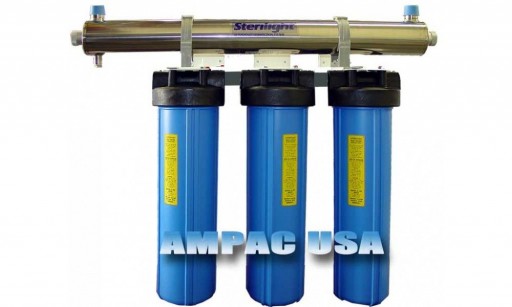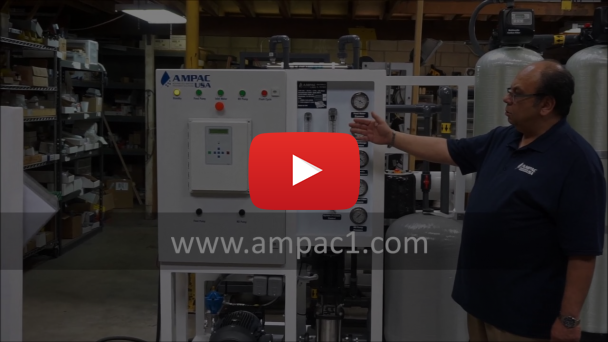
LOS ANGELES - June 29, 2019 - (Newswire.com)
Water is a major point of concern for countries around the globe, especially third world countries. The climate is not helping, and the prices go up every year, making it an important commodity. If there isn’t the problem of scarcity, there is of contamination. WHO predicts 844 million people lack even a basic source, including 159 million people who are dependent on rivers and lakes. The question, therefore, arises, how can we make a constant supply available for future generations if we aren’t able to do it today?
Water without any contamination is a basic human right and, without it, people die every year. Sammy Farag, CEO of AMPAC USA, adds, “Scarcity, stress, shortage, all of it was predicted decades ago. The rate at which we are using water in our daily lives is very astonishing. Where on one hand an average person in the U.S. spends 20 minutes in the shower, someone else in the world is struggling for a glass of water. It really is heartbreaking that people die each year because they have nothing to drink.”
The comparison surely is very drastic and really puts a lot of things into perspective. An average American family uses 522 gallons on a daily basis. This includes drinking, cleaning, washing, cooling, showers, brushing, gardening and more. Most of this is delivered to their home via pipes and taps. And on the other hand, an average African family uses five gallons each day. In developing countries like Africa, women walk an average of four miles each day to fetch it in earthen pots, which may or may not be sanitary. That is 40 billion work hours wasted each year in search of drinking water.
According to the UN, an average person needs 5.3 to 13.2 gallons each day for drinking, cooking and sanitation.
Sustainable Water
Countries and governments have already taken the hint and have begun working on preserving what little surface water is left. While many are using the sea to their advantage, sustainability has yet to be achieved. It can be done through individual efforts, Farag agrees.
“No matter what the governments or corporations do, any goal is achieved by the team. There are more than 7 billion people in the world and the efforts made by the ones in power equal to maybe 1 billion people. There are still 6 billion others who can decide to make a change and start living a lifestyle that is environment-friendly. Efforts on an individual level can prove to be a lot more helpful than one might think.”
There is a question of how. People over the years have become accustomed to technology. Decades ago, people could see houses built by wood and harvesting systems, working perfectly in order to sustain the needs of the people living in it. But today, people need technologies to make their lives simpler. There are fewer wooden houses today and concrete jungles increase by the day. The question, therefore, is how can we give people a way to be more responsible and helpful?
Water Harvesting systems are an upcoming trend in the effort for sustainability. The equipment, too, is easily available. “It can be installed while building a home. And it can be very efficient with the right design. It only involves collecting rain and storing it for months at a stretch in a tank that supplies it to the house through a network of pipes and taps. Theoretically, it can make a house 100% independent of external supply,” says Farag. “That is sustainable water right there!”
Add a hint of already advanced water tech, and this system feels good to go. Farag feels reverse osmosis has a role to play.
Reverse Osmosis As A Tool
Reverse osmosis, today, is mainly used for treating already available water of any contaminants and makes it risk-free and healthy for drinking. The UN recently published some key facts suggesting that
- In 2015, 71% of the global population (5.2 billion people) used a safely managed service – that is, one located on the premises, available when needed, and free from contamination.
- 89% of the global population (6.5 billion people) used at least a basic service. A basic service is an improved source within a round trip of 30 minutes to collect water.
Even though this is, in fact, good news, today, 783 million people, or 11% of the global population, still do not have access to clean drinking water, and 2.5 billion people live without basic sanitation.
“Reverse osmosis hasn’t reached everyone, even today, even though its benefits are tremendous. RO systems give you water based on your requirements -- healthy and nutritious too. Making it available everywhere can help decrease the risk of diseases transmitted through the liquid. Contamination can cause diseases such as diarrhea, cholera, dysentery, typhoid and polio. Contaminated water is estimated to cause 502,000 diarrheal deaths each year,” said Farag.
Sure RO is a purifying system, but how does it help in saving water?
“Rejected water,” says Farag. “RO systems are designed to allow a particular standard of liquid molecules into the other side. Which means, even if it comes from rain, there is a good chance it would have a 98-99% rejection rate, that means a lot of it will not qualify as healthy. This rejected quantity has immense possibilities.”
Sure enough, RO does reject a lot of water. But Farag thinks that can be used as an advantage. For the people who already have a house and are not planning on building one for the next few years and still wish to harvest it, RO can be a great solution. Creating a system in a house that has been standing for years is a tough job. Even with a better design, the structure may not be as effective as one would wish it to be. But if one wants, they can begin by collecting rain and storing it. The filtration part is taken care of by RO. Rain, though potable, can have many contaminants present. RO can help purify it, and the rejected quantity can be used for a number of purposes. Recycling can be done by using it to water plants, wash cars, clean floors, sewage systems and more. It is a very good alternative to creating a harvesting system from scratch in an already built house.
Seawater Desalination
The biggest example of reverse osmosis being put to good use is seawater desalination. Plants have been set across the world in Australia, U.S. Saudi Arabia and more, where each day tens of thousands of gallons of fresh water is produced from the endless supply of the sea.
“It is a growing trend. It has given hope to countries where the geography is not naturally blessed with rivers and reservoirs. People have begun irrigation and agriculture thanks to the abundant supply. Reverse osmosis makes the process effective. Still, we have miles to go in technology, regarding its environmental effects. As long as availability is concerned, RO in these plants makes water available instantly, but it can be a problem for the marine ecosystem in the nearby areas. That area is yet to be explored and needs to be done soon,” Farag concluded.
It is true that rejected water from these plants has proven to be a problem in the marine ecosystem nearby. However, the benefits of reverse osmosis in the sustainability of water are far more than the disadvantages. It would, therefore, be better to create advanced technologies that smash disadvantages to make them truly eco-friendly and the best alternative.

Related Links
Commercial Reverse Osmosis
Industrial Reverse Osmosis
Press Release Service by Newswire.com
Original Source: Reverse Osmosis for Water Sustainability - AMPAC USA

